Story by Buzz Bourdon (late the RMR 1975-82)

As the haunting and evocative notes of ‘The Last Post’ soared into the air, the soldiers of The Royal Montreal Regiment stood solemnly at attention, their heads bared in tribute.

Nearby, close to 150 people of all ages stood watching quietly, as the RMR conducted its annual Remembrance Day ceremony on Nov. 8, 2015, at the Westmount War Memorial on Sherbrooke street, near city hall. In front of the crowd stood some of the great and good of Westmount, including Mayor Peter Trent.
The annual ritual is a time for silent reflection and private sorrow, a chance to remember those who served and fought in the RMR’s wars of the 20th century, both the First and Second World Wars, the Korean War, the peacekeeping conflicts in the former Yugoslavia 20 years ago and the recent war in Afghanistan. Some of the soldiers on parade wore the General Campaign Star, to denote combat service in the last-named war.

Since the early 1920s, the RMR has paraded once a year to pay tribute to its war dead. The RMR provided the guard of honour, nearly 1,000 men strong, for what was likely Canada’s first cenotaph: Westmount’s unveiled in 1922, with General Currie in attendance. For years the Regiment attended Montreal’s main ceremony, held at Dominion Square on November 11, in company with the city’s other reserve units, and the Westmount ceremony. Now, for many decades, the regiment has paraded in Westmount on the Sunday before November 11. The RMR also participates in a parade in Pointe Claire several hours before the Westmount ceremony, and in the past decade has been actively participating in the Hampstead parade.
The website of the Canadian War Museum says this about the history of the ceremony:
Armistice Day was inaugurated in 1919 throughout much of the British Empire, but on the second Monday in November. In 1921, the Canadian Parliament passed an Armistice Day bill to observe ceremonies on the first Monday in the week of 11 November, but this combined the event with the Thanksgiving Day holiday. For much of the 1920s, Canadians observed the date with little public demonstration. Veterans and their families gathered in churches and around local memorials, but observances involved few other Canadians.
In 1928, some prominent citizens, many of them veterans, pushed for greater recognition and to separate the remembrance of wartime sacrifice from the Thanksgiving holiday. In 1931, the federal government decreed that the newly named Remembrance Day would be observed on 11 November and moved Thanksgiving Day to a different date. Remembrance Day would emphasize the memory of fallen soldiers instead of the political and military events leading to victory in the First World War.

Half of the 81 soldiers of the RMR were dressed in their DEU service dress uniforms, complete with white belts and gloves, and C-7 automatic rifles, while the other half wore the CADPAT combat uniform, with C-7s. There were two other army reserve units on parade: 34 Signals Regiment had 43 personnel and 2 Field Regiment, Royal Canadian Artillery, had 25.
Both RMR cadet corps were also on parade, 2862 from the RMR armoury and 2806 from Pointe Claire. No. 1 (West Montreal) Squadron, Royal Canadian Air Cadets, was also present.
Each person on parade wore a red poppy on their uniform. The war museum describes this tradition:

The red poppy, a native plant along much of the Western Front during the First World War, has become a powerful symbol of remembrance. It is the principal emblem of the Royal Canadian Legion, which distributes several million each year to be worn by Canadians on Remembrance Day.
The familiar symbol of the poppy owes much of its fame to Canadian poet and soldier John McCrae. In Flanders Fields, McCrae’s best-known poem, was inspired by and made reference to the poppies which grew along the Western Front. It opens, “In Flanders fields the poppies blow / Between the crosses, row on row…”
The blood-red poppy had long been associated with the fighting armies of Europe, and the flowers often overgrew the mass graves left by battles. During the First World War, enormous artillery bombardments completely disrupted the landscape, infusing the chalk soils with lime. The poppies thrived in the environment, their colours standing out against the blasted terrain.
In 1921, the Great War Veterans’ Association, the largest of several Canadian veterans groups, adopted the poppy as a symbol of remembrance. The Canadian Legion, formed in 1925, continued this connection. The poppy was worn on the left lapel and close to the heart to recognize the sacrifice of soldiers in times of war. They were initially made by disabled veterans and the proceeds of sales, then and now, go towards funding veterans’ needs.
The poppy remains an enduring symbol of remembrance in Canada, Great Britain, the nations of the Commonwealth, and in the United States for those who served or fell in service of their country.

After the RMR’s regimental sergeant-major, MWO David Cochrane, formed up the various guards and units, the RMR’s colour party, consisting on the Queen’s and Regimental Colours, plus escort, was marched on parade. Carrying the Queen’s Colour was Lt Anas Anani, while 2Lt Rayan Ezedin carried the Regimental Colour.

This stand of colours, the RMR’s fourth in 101 years, was presented by Gilles Lamontagne in 1989, the then lieutenant governor of Quebec. The three escorts, who symbolize protecting the colours with fixed bayonets, were Sgt Kaz Rutkowski, Sgt Yozek Butera and Sgt Alexey Oleshko.
The commanding officer of the RMR, LCol Jean-Francois Denis, took over the parade from the deputy CO, Maj Jung-Kwon Seo, then gave the orders that sent the parade marching onto Ste Catherine street, preceded by the Band of Les Fusiliers Mont-Royal. It was conducted by Capt Pierre Leblanc.
An impressive part of this year’s parade was the 20 members of the RMR Association, Branch 14, The Royal Canadian Legion. Looking extremely dapper in their blue blazers, medals and scarlet berets – the RMR wore scarlet berets complete with its brass capbadge from the 1940s until 1972 – the members of Branch 14 were led by their president, Comrade Sue Guerin. She joined the RMR in 1980 and eventually retired as a warrant officer.
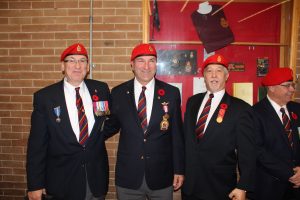
Many of the Branch 14 members on parade had been RMR stalwarts during the 1970s: Bill Thibault, Rick Guevara, Mike Jones, Georges Gohier, Harry Hall, Dave Smith, Lech ‘Boris’ Kwasiborski and Joel Tartiere. All but one were eventually promoted to the Warrant Officers and Sergeants’ Mess. Hall was commissioned as an officer in 1979 and later commanded the regiment twice. Kwasiborski was awarded the Star of Courage, by the governor general of Canada, for rescuing three men from a burning car years after he retired from the RMR in 1987.
The ceremony at the Cenotaph….
After the parade, which was about 200 strong, arrived at the war memorial at 2 p.m., the band played ‘O Canada’ and a former padre of the RMR, LCol (ret’d) the Rev. John Zoellner, gave a short address of welcome. The hymn ‘O God our help in ages past’ was sung and religious leaders gave short prayers.

Standing at attention on each of the four corners of the base of the memorial were four reservists, their heads bowed in tribute and their C-7 rifles reversed, the end of the barrels resting on a boot. This symbolizes that that the army is mourning its dead.
The flags of Canada, Quebec and Westmount flapped in the breeze – the sky was blue, the sun shone and the weather was a very tolerable 7 degrees – as many of those present repeated the prayers. A few feet from the clerics, the war memorial loomed over the proceedings, the statue of winged victory, with arm outstretched, guiding forward a soldier looking up.
The memorial was sculpted by George William Hill (1862-1934), described as one of Canada’s foremost sculptors during the first half of the 20th century. He produced numerous public memorials and was a member of the Royal Canadian Academy of Arts.
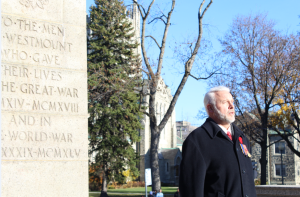
The inscription on the front of the memorial reads as follows: “To the men of Westmount who gave their lives in the Great War/ MCMXIV-MCMXVIII. Below that inscription is a similar one for the Second World War. On the back, another inscription says; “Their Name Liveth for Evermore.” Surrounding the memorial on three sides are three waist-high monuments inscribed with the names of the dead.
One of the names is Lyall Price, the oldest son of the father of the RMR, MGen Charles Basil Price. MGen Price was the original RSM of the RMR when it was organized in August, 1914, as the 14th Battalion, Canadian Expeditionary Force. He commanded the unit twice in the 1920s and was the honourary colonel from 1943-57. His son Lyall, a bomber pilot with 408 Squadron of the RCAF, was 22 when he died in a flying accident on July 22, 1942. He was awarded the Distinguished Flying Cross and held the rank of squadron leader (major in the army).
Then came the climax of the parade. Those soldiers armed with C-7 rifles presented arms while others saluted for the traditional and evocative minute of silence, as a musician from the FMR band played the ‘Last Post.’ The Canadian flag was lowered in tribute. The first stanza of the famous poem by Laurence Binyon, now considered The Act of Remembrance”, was read:
They shall not grown old as we who are left grow old,
Age shall not weary them, nor the years condemn.
At the going down of the sun and in the morning,
We will remember them.
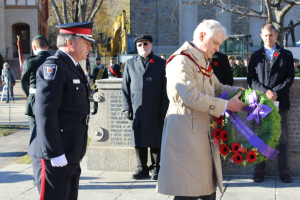
Representatives from the following organizations laid wreaths at the foot of the memorial: the government of Canada, the government of Quebec, the city of Westmount, RMR Association, Branch 14, 34 Field Engineer Regiment, 2 Field Regiment, RCA, 34 Signals Regiment, the RCMP and both RMR cadet corps.
For the RMR, the honourary lieutenant colonel, LCol (ret’d) Colin Robinson, CD, laid a wreath, accompanied by the CO and the RSM. The service ended with the band playing ‘God Save the Queen.’
A few minutes after the parade marched off, Mayor Peter Trent of Westmount took the salute from the various units, as he stood on a dais beside Sherbrooke street. Once back in the RMR’s armoury, both guest units and the two cadet corps were dismissed before the RMR held a battalion review ceremony.
Back in the armoury….

After the colours were marched on, LCol (ret’d) Robinson inspected the troops, accompanied by Mayor Trent and Reverend Wheeler. Led by its new commanding officer – LCol Denis took command on Oct. 25 -the unit marched past its HLCol. Then, the Rev. Patrick Wheeler of St Matthias’ Anglican Church took the RMR’s Book of Remembrance – it has the names of the RMR’s war dead inscribed in it – and offered a prayer. At this point, the officers had returned their swords into their scabbards and the entire parade had removed their headdress.
The Rev. Wheeler then gave the prayer of rededication for the armoury, which is done annually at this time: “Almighty and Eternal God, King of Kings, who inspired men to erect this building for the training of individuals to serve their Queen and Country, and to the memory of the gallant dead of this and sister regiments, who laid down their lives in World Wars I and II, we rededicate this building to thy service, and to the service to our country and the Commonwealth. And we pray that those who now, and in time to come, train within these walls may be true to the high and noble ideals of those fallen comrades, who made the name of this Regiment glorious in service. And may we give ourselves to the establishment of truth, justice righteousness and peace in the world.”
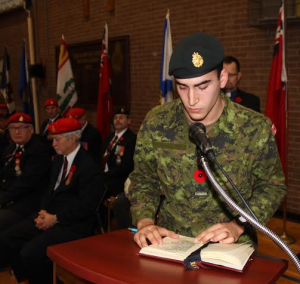
The youngest soldier in the RMR, Pte Jeremy Kafoury, 17, then read a page of names from the RMR’s roll of honour. Every year, a different page of names is read – always by the youngest soldier, according to RMR custom.
Before the parade ended with the RMR advancing in review order and presenting arms for the playing of ‘O Canada,’ one of the RMR’s former regimental sergeants-major was honoured with a presentation.
One of the RMR’s Own….
Capt (ret’d) Georges Gohier, who joined the RMR in 1970 – he was on the same recruit course with ‘Boris’ Kwasiborski and Bill Thibault – was presented with the third clasp to the Canadian Forces Decoration (CD). The CD is awarded to all members of the Canadian Forces who have completed 12 years of service, with a good record of conduct. A clasp is awarded for every subsequent period of ten years. Capt (ret’d) Gohier’s third clasp represents 42 years of service.
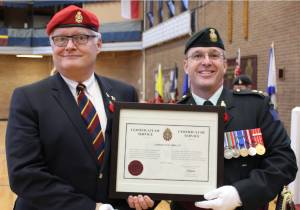
Capt (ret’d) Gohier was RSM of the RMR in the 1990’s and later also served as RSM of 3 Field Engineer Regiment before accepting a commission as an officer. He was also presented with his certificate of service (October, 1970 to June, 2014) and a Canadian flag that flew over the headquarters of Montreal garrison on Sept. 18, 2014. All ranks wish Capt (ret’d) Gohier well on his retirement. He’s not going anywhere, though, since he lives in the building across the alley from the armoury, serves as Vice-President of the RMR Association, and has recently joined the RMR Foundation as a member.
So another Remembrance Day ceremony ended for the soldiers of the RMR. There have been some 95 of them since the RMR was founded 101 years ago. Those who served in Afghanistan remembered the casualties suffered during their tour while others may have pondered the meaning of service and sacrifice as citizen soldiers in the forces of the Crown. This simple yet evocative ceremony will be held at the same time and place next year, and every year after that. It is a necessary ritual that reaffirms the RMR’s history and remembrance of the past, and the cost.
Honi Soit Qui Mal Y Pense.

